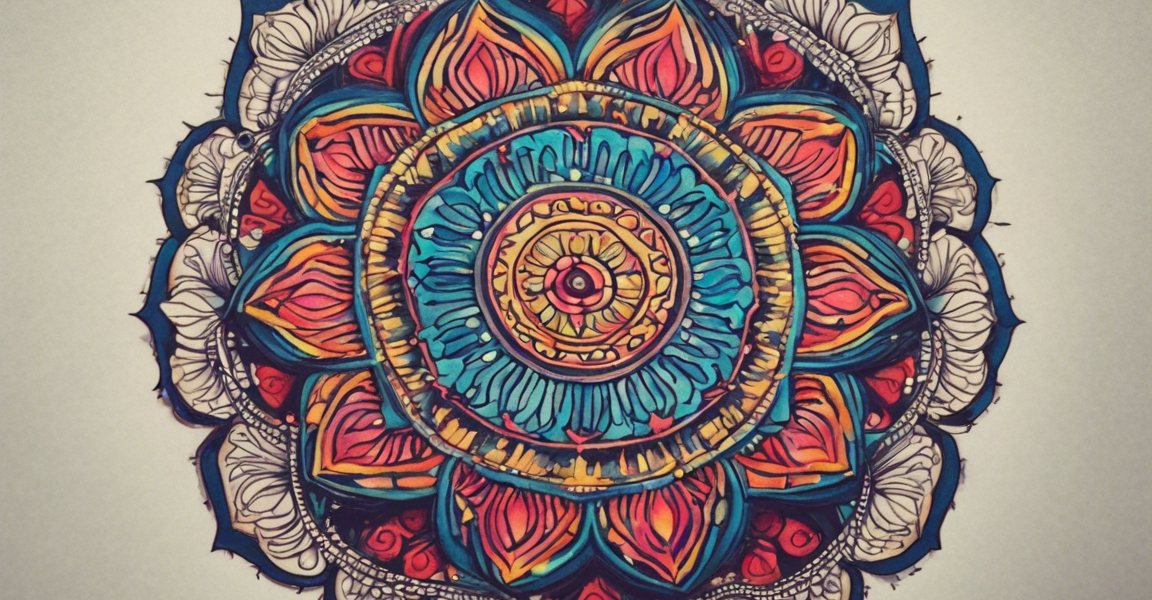Introduction
Mandala art, a complex and mesmerizing form of geometric design, has been used for centuries in various cultures as a tool for meditation, self-discovery, and spiritual connection. The word “mandala” is derived from the ancient Indian language of Sanskrit, meaning “circle” or “discoid object.” These intricate patterns often start with a central point and radiate outwards in symmetrical shapes, creating a sense of balance and harmony. In this article, we will delve into the captivating world of mandala art designs, exploring its history, significance, symbolism, and therapeutic benefits.
Origin and History
The roots of mandala art can be traced back to various ancient civilizations, including Hinduism, Buddhism, and Native American cultures. In Hindu and Buddhist traditions, mandalas are used as spiritual symbols representing the universe and the interconnectedness of all beings. They are often used in religious rituals, meditation practices, and as tools for focusing the mind.
Mandalas in Different Cultures
-
Hinduism: In Hinduism, mandalas are used to represent the cosmos and the spiritual journey towards enlightenment. They are often found in temples and are used as aids for meditation and concentration during religious ceremonies.
-
Buddhism: Mandalas play a crucial role in Tibetan Buddhism, where they are created as intricate sand paintings known as “sand mandalas.” These are meticulously crafted by Buddhist monks as a form of meditation and are then ceremonially destroyed to symbolize the impermanence of life.
-
Native American Cultures: Indigenous tribes in North and South America have also used mandalas in their traditions, often in the form of intricate patterns woven into textiles, pottery, and jewelry. These designs symbolize the interconnectedness of all living beings and the cyclical nature of life.
Symbolism and Meaning
Mandala art is rich in symbolism, with each element holding deep spiritual significance. Some common symbols found in mandalas include:
- The Circle: Represents unity, wholeness, and the cyclical nature of life.
- The Square: Symbolizes stability, balance, and the four elements (earth, air, fire, water).
- The Lotus Flower: Signifies purity, enlightenment, and spiritual growth.
- The Sun and Moon: Represent the masculine and feminine energies, as well as light and dark forces in the universe.
Therapeutic Benefits of Mandala Art
Creating and coloring mandalas can have a profound impact on one’s mental, emotional, and spiritual well-being. Some of the therapeutic benefits of mandala art include:
- Stress Reduction: The repetitive and intricate nature of mandala designs can help calm the mind and reduce stress and anxiety.
- Improved Concentration: Focusing on coloring or creating a mandala can enhance concentration and mindfulness, helping to improve cognitive function.
- Self-Expression: Mandala art provides a creative outlet for self-expression and can be a form of non-verbal communication of emotions and feelings.
- Spiritual Connection: Many people find that working with mandalas deepens their spiritual practice and fosters a sense of connection to something greater than themselves.
How to Create Mandala Art
While traditional mandala designs are often intricate and complex, anyone can create their own mandalas with some basic tools and techniques. Here are some steps to get started:
- Start with a Circle: Begin with a blank circle as your central point, either drawn or traced using a compass.
- Divide the Circle: Use a ruler to divide the circle into sections or segments to create symmetrical patterns.
- Add Geometric Shapes: Experiment with adding geometric shapes such as triangles, squares, and circles within the divided sections.
- Incorporate Details: Fill in the shapes with intricate patterns, lines, dots, and curves to create a visually appealing design.
- Color Your Mandala: Once your design is complete, use colored pencils, markers, or paints to fill in the shapes with vibrant colors.
Frequently Asked Questions (FAQs)
- What is the purpose of mandala art?
-
Mandala art is used for meditation, self-expression, spiritual practice, and therapeutic purposes.
-
Can anyone create a mandala?
-
Yes, anyone can create a mandala, regardless of artistic skill or experience.
-
Are there specific colors used in mandalas?
-
While there are no strict rules, traditional mandalas often feature vibrant colors with symbolic meanings.
-
How long does it take to create a mandala?
-
The time it takes to create a mandala varies depending on the complexity of the design and the artist’s skill level.
-
Are there different types of mandalas?
- Yes, there are various types of mandalas, including traditional, contemporary, and personal mandalas tailored to individual preferences.
In conclusion, mandala art designs offer a gateway to self-discovery, creativity, and spiritual exploration. Whether you are looking to relax, meditate, or simply unleash your creativity, engaging with mandalas can be a deeply fulfilling and enriching experience. So pick up a pen, start drawing, and let the transformative power of mandalas guide you on a journey of inner harmony and balance.



